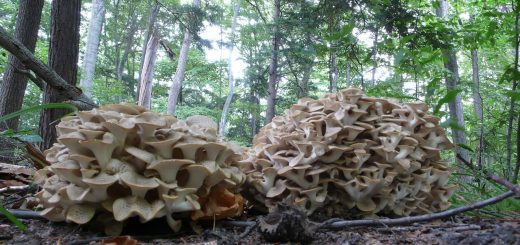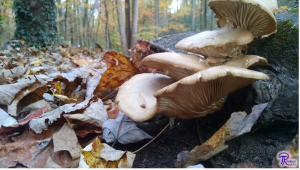#064: Endangered Fungal Species
We normally think of fungi as magical organisms that appear out of nowhere and resist all our attempts to get rid of them. Despite their mysterious nature, fungi are not impervious to environmental change. The IUCN Red List currently contains five fungal species, ranging in threat assessment from vulnerable to critically endangered. Given that there are an estimated 1.5 to 5 million fungal species worldwide, this may seem like good news for fungi. However, I suspect that the low numbers of endangered fungi are due to the fact that it is almost impossible for us to monitor fungal populations. Most fungi are only visible when they produce mushrooms and may not be found in the same place every year. This makes it extremely difficult to track fungi over time by sight. A new alternative is to test a soil sample for the presence of specific fungal genes. This method, however, is costly and requires a lot of luck. Given these difficulties in tracking fungi, it is not surprising that four of the five Red List fungi are lichens. Lichens grow on top of surfaces and are visible year-round, making it easy to keep tabs on individuals and populations.
Meet the IUCN Red List Fungi:
Anzia centrifuga (vulnerable):
This lichen is pale gray and foliose, with thin, branched lobes. The underside is velvety, which is typical in this genus. A. centrifuga is only found in two small subpopulations on the island of Porto Santo in the Madeira Archipelago (Portugal). There is no population size data, but the small area inhabited by this species means it could easily be wiped out by fire, grazing, or trampling. Increased tourism could be very detrimental to this lichen.
Cladonia perforata, the Florida Perforate Reindeer Lichen (endangered):
This yellowish-gray, fruticose lichen forms an upright, branched structure. The branches arise from spore-producing structures (although no spores are produced) and form intricate tufts. Conspicuous holes dot these branches and give the lichen its name. C. perforata lives in the Florida panhandle and in central Florida, with fragmented populations found from the Atlantic to Gulf coasts. This lichen thrives in scrubland, so periodic fires or hurricanes are needed to remove large plants and maintain the sunlit habitat. However, these natural disasters can easily wipe out the small, fragmented subpopulations. There are currently 32 known subpopulations, two of which had to be reintroduced in 2000 after Hurricane Opal. The lichen spreads when small pieces break off from the main thallus, which occurs through trampling, age, wind, or other mechanisms. These pieces cannot travel very far, so each subpopulation is effectively isolated from the others. C. perforata is listed as an endangered species by the U.S. Fish and Wildlife Service and there are active conservation efforts protecting it.
Gymnoderma insulare (endangered):
This light green, foliose lichen lives at the bases of veteran trees in old growth forests of Japan and Taiwan. G. insulare is only found growing on two tree species: Cryptomeria japonica (in Japan) and Chamaecyparis obtusa (in Taiwan), both of which are listed as threatened by the IUCN. There are only five subpopulations of G. insulare remaining. Most of its habitat was lost due to logging, and old growth forests only exist at a few protected sites today. Its old growth forest habitat also makes it extremely susceptible to typhoons, which can destroy large swaths of potential habitat. A sixth subpopulation was eradicated by a typhoon in 1991.
Erioderma pedicella, the Boreal Felt Lichen (critically endangered):
This lichen once occupied a range spanning Canada, Norway, and Sweeden. During the past three generations (approximately 100 years for this slow-growing species) the Boreal Felt lichen has disappeared throughout most of its range. Today, it can only be found in Nova Scotia and Newfoundland. The top of the Boreal Felt Lichen is dark blue, fuzzy, and dotted with reddish spore-producing structures. It can be found growing in old growth, highly oceanic, coniferous forests. It once grew in Norway and Sweeden on Norway Spruce in temperate rainforests. In Canada, it primarily grows on Abies balsamea and occasionally on Picea mariana. E. pedicella is highly susceptible to atmospheric pollutants like acid rain. Pollution and the loss of old growth forests due to logging have irreversibly decreased the global population of this lichen by more than 80%. As of 2003, there were 14 individuals in Nova Scotia and 5,074 individuals in Newfoundland. Despite the seemingly large numbers in Newfoundland, the lichen remains rare in this habitat.
Pleurotus nebrodensis, the White Ferula Mushroom (critically endangered):
This is the only unlichenized fungus on the IUCN Red List. It is only found in fragmented populations in the Madonie Mountains of northern Sicily between 1,200m and 2,000m in altitude. Within this area, it only grows on limestone substrates and only in association with Cachrys ferulacea (a member of the celery family). This fungus forms medium-sized, fleshy, white mushrooms with gills. It has a roughly central stipe and circular cap, though individuals are often slightly irregular in a variety of ways. Like its relative P. ostreatus (the Oyster Mushroom), the White Ferula Mushroom is edible and has been called “the most delicious mushroom of the Sicilian mycological flora.”* Because of their rarity, these wild mushrooms usually fetch between 50 and 70 Euros per kilogram. This high price encourages people to collect and sell the mushrooms, often before they are mature. Pressure from humans picking the fruiting bodies is the main threat faced by P. nebrodensis today. It is estimated that only 250 individuals produce mushrooms each year. There are currently no laws protecting this species in the wild, but it can be cultivated fairly easily. Cultivation will hopefully relieve some of the pressure on the wild species.
In the United States
The U.S. Fish and Wildlife Service lists two lichens as endangered: Cladonia perforata, the Florida Perforate Reindeer Lichen (described above) and Gymnoderma lineare, the Rock Gnome Lichen. G. lineare is easily recognized by its unusual squamules. These squamules are thin and extend perpendicular to the rock faces on which it grows. They are blue-green on top, white on the bottom, and fade to black at the base. This foliose lichen is found in the Appalachian Mountains of North Carolina, South Carolina, Tennessee, and Virginia. The Rock Gnome Lichen only grows in areas with a high humidity, like high cliffs that are frequently bathed in dense fog, rock faces with water seepage from the soils above, or boulders at the bottom of stream gorges. The Rock Gnome Lichen’s habitat is mostly threatened by loss of Fraser-fir forests and by increased recreational activities in its habitat.
The groups of fungi that have received the most attention in the United States are lichens and sequestrate fungi of the Pacific Northwest. The latter is of interest because it includes truffles, which are valuable edibles. As of 2005, it was estimated that around 6% of the known lichen species in the United States and around 18% of the known sequestrate fungi in the Pacific Northwest were imperiled. Because of the high biodiversity in the Pacific Northwest, the latter number is probably higher than for other groups of fungi in the rest of the country. If we assume that 6% to 18% of fungi in the United States are imperiled, then the true number of imperiled fungi in our country is between 2,200 and 6,800. If this trend reflects global patterns, then we are certainly not doing enough to protect our fungal species.
See Further:
http://www.iucnredlist.org/details/64081145/0
http://www.iucnredlist.org/details/43994/0
http://ecos.fws.gov/speciesProfile/profile/speciesProfile?spcode=U000
http://www.iucnredlist.org/details/43995/0
http://www.iucnredlist.org/details/58520980/0
* http://www.iucnredlist.org/details/61597/0
http://ecos.fws.gov/speciesProfile/profile/speciesProfile?spcode=U001
http://www.centerforplantconservation.org/collection/cpc_viewprofile.asp?CPCNum=15829
http://explorer.natureserve.org/servlet/NatureServe?searchName=Gymnoderma+lineare
http://www.webpages.uidaho.edu/css235/Wilcove_and_Master_How_Many_Species.pdf
If you are interested in endangered fungi outside the United States, you’ll have to do some research on your own for your specific region of interest. Australia is relatively good at acknowledging its endangered fungi. The Australian list includes 8 Hygrocybe species (Waxy Caps) and another small agaric. Here is the link to Australia’s threatened species list (to find the fungi, un-check the box marked “key threatening process” and un-check the boxes for animals, plants, algae, communities, and populations): http://www.environment.nsw.gov.au/threatenedSpeciesApp/








![#011: Characteristics of Kingdom Fungi [Archived]](https://www.fungusfactfriday.com/wp-content/themes/hueman/assets/front/img/thumb-small-empty.png)

